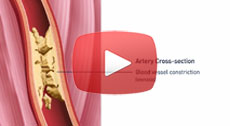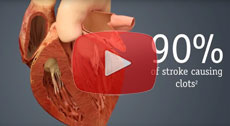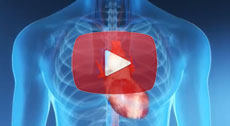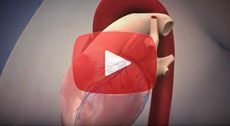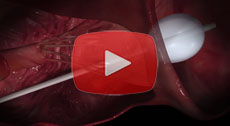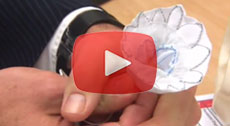Tests and procedures
A device that measures blood pressure at regular intervals for 24 hours during normal daily/nightly activity. Patients may have this device if they have high blood pressure (hypertension) or variable blood pressure which is difficult to control. A small device worn on a belt or around the neck is connected to a blood pressure cuff on the arm. Throughout the day and night the cuff inflates every 30 to 60 minutes and the patient’s blood pressure is recorded.
A stent is implanted into the aorta to treat aortic coarctation (aortic arch narrowing). The stent is placed at the site of the narrowing using a catheter inserted into a major artery. The stent is then implanted and dilated to widen the artery.
Ablation delivers electrical energy to the inside of the heart to change abnormal tissues. The heat energy cuts off the abnormal pathways and may prevent abnormal heartbeats. A mild burning feeling may be felt in the chest when the abnormal pathway is being cut off. This is the ‘ablation’. The burning feeling will lessen when the ablation stops.
Computer Tomography (CT) or ‘CAT’ scans are special x-ray scans that produce cross-sectional, highly detailed pictures of the body using x-rays and a computer. The structure and function of the heart are recorded non-invasively and may eliminate the need for an invasive angiogram. The scanning machine takes multiple pictures of the heart and coronary arteries and is capable of generating a three dimensional (3D) picture of the heart.
Cardio MEMS is a device which is implanted into the pulmonary artery to monitor pulmonary artery blood pressure and alert the treating cardiologist if there are changes in pulmonary artery pressure. The device is used by cardiologists to adjust medications based on the patient’s pulmonary artery pressures and reduce the number of hospitalisations due to heart failure.
Electrical cardioversion is a procedure used to convert an abnormal heart rhythm (such as Atrial Fibrillation AF) to a normal rhythm (sinus rhythm). A defibrillator is used to deliver specific amounts of energy to the heart muscle through patches placed on a patient’s chest to restore a normal heart rhythm. Patients receive general anaesthetic for this procedure.
A Coronary Angiogram displays any narrowing or blockage of the coronary arteries. A catheter is inserted into an artery in the wrist or groin and gently directed to the heart and the coronary artery. A dye is then injected into the coronary artery and the heart’s pumping chambers. X-ray pictures are taken of the heart and artery to determine the location and size of any blockages.
The insertion of balloons and stents to open blocked coronary arteries. In this procedure a catheter is inserted into the arm or groin and gently directed to the heart and the coronary artery. The catheter is delivered to the site of the blockage where a balloon and/or stent is deployed to widen it. A stent is a permanent implant to reshape the blood vessel.
Consent information – Coronary Angiogram and/or Angioplasty and Stenting
Discharge information – Angioplasty
Widening blood vessels (angioplasty) and stabilising blood vessels (stenting)
The coronary calcium score is a non-invasive CT scan for patients who are at medium risk of cardiovascular events. This is a test to see how much calcium is in the coronary arteries.
A Dobutamine stress echocardiogram is a test which assesses the heart’s function and structure while it’s under stress. This test is usually used with patients who are unable to exercise. Dobutamine is inserted into a vein to make the heart beat faster instead of having the patient exercise to increase the heart rate. Ultrasound pictures are recorded before, during and after the test.
A test that measures the electrical activity in the heart to check for normal, abnormal, or unusual activity. The ECG provides doctors with invaluable information on the electrical rhythm of the heart, electrical conduction, muscle mass, the presence of arrhythmia, ischaemia or infarction and the effects drugs may be having on the heart. It is a harmless, painless procedure which can last up to 10 minutes.
Electrophysiology studies are performed on patients who have rhythm disturbances in their hearts (arrhythmia). The electrical function of the heart is studied to determine its susceptibility to very fast or very slow rhythms. Specialised catheters are passed through the groin to the heart to determine an arrhythmia diagnosis or the mechanism of a diagnosed arrhythmia. Once the origin of the arrhythmia is determined an ablation catheter may be inserted to neutralise (ablate) the cells which cause the problem.
The stress echocardiogram measures the function of the heart, lungs and blood vessels before, during and after exercise. It is done to help diagnose blocked arteries in the heart (coronary artery disease) and also provide specific information about valvular disease and pressure in the heart and lungs. The patient exercises on a treadmill to make the heart work harder. Ultrasound pictures are then taken of the heart to complete the diagnosis.
The exercise stress test is designed to assess how the heart, lungs and blood vessels respond to exercise. The test helps to diagnose blocked arteries in the heart (coronary artery disease), assess abnormal heart beats or to check the function of pacemakers. It also provides information on a patient’s ability to exercise.
A hole in the wall of the heart or atrial septal defect (ASD), Patent Foramen Ovale (PFO) or Ventricular Septal Defect (VSD) are conditions which allows blood to flow between the chambers across the septal wall. The hole is repaired using a double-sided patch delivered by catheter directly to the heart chambers.
Consent information – Atrial Septal Defect Repair
A Holter Monitor is a small battery-powered device which continuously records heart activity for 24 to 48 hours. The holter monitor is a continuous testing device which picks up heart rhythm and heart rate and will also record irregular heartbeats (arrhythmia). The device is attached by electrodes to monitor heart function on a long-term basis.
A portable electrocardiogram device that a patient wears for 2 weeks to record heart rhythms and correlate with symptoms.
An Implantable Cardioverter Defibrillator (ICD) helps to slow down a fast heartbeat. It is an electronic device implanted in the left hand side of the chest under the collarbone. The ICD continuously monitors heart activity and is implanted to potentially treat dangerous or lethal fast heart rhythms. When it detects abnormal fast heart rhythms it delivers a rapid burst of impulses or a shock to the heart to bring the rhythm back to normal.
Consent information – Implantable Cardiac Defibrillator (ICD)
Discharge information – Implantable Cardioverter Defibrillator (ICD)
A device implanted underneath the skin which records and monitors heart rhythms. The device monitors symptoms relating to heart disease such as fainting, dizziness, seizures, light-headedness or palpitations.
A catheter is inserted in the large vein in the groin and is progressed to the left atrium. The device is positioned using x-ray and ultrasound guidance.
Left Atrial Appendage Closure with the WATCHMAN™ device
A myocardial biopsy is taken when a doctor suspects there is a problem with the heart muscle. The biopsy involves taking a small piece of the myocardium (heart muscle) and sends it for analysis. A special type of catheter called a bioptome is inserted into the neck, arm or groin to extract the sample. This procedure can help diagnose deterioration or inflammation of the heart muscle.
Consent information – Cardiac Biopsy (Femoral Vein Approach)
Consent information – Cardiac Biopsy (Internal Jugular Vein Approach)
A myocardial perfusion scan is a test that is used to look for major blockages to the blood supply of the heart commonly known as coronary artery disease. There are several parts to the test including a rest scan, stress test, stress scan and redistribution scan. The parts of the test may be in a different order depending on your condition.
A pacemaker is an implanted device that can regulate heart rhythms from going too slow. A slow heart rate can be serious and if the electrical system of the heart is damaged a pacemaker will help the heart beat normally. The pacemaker is surgically placed under the skin below the collar bone and sends an electrical impulse to the heart if it senses the heart beat has slowed down.
Consent information – Pacemaker
The pacemaker or implantable cardioverter defibrillator (ICD) generator (battery) is replaced. The leads that are attached to the heart are disconnected from the old generator and reattached to the new generator.
A lead extraction is when one or more leads from a pacemaker or implantable cardioverter defibrillator (ICD) are removed from the heart. Pacemaker and ICD lead extractions are necessary if there is an infection or malfunction. If there is an infection the device will be removed and the infection treated before a decision is made to replace the device.
A paravulvular leak occurs when there is backflow of blood around a prosthetic valve in the heart. The leak is repaired using a special vascular plug which is delivered through the groin using a catheter.
This is an abnormal opening between two major blood vessels, the aorta and pulmonary artery. This opening allows blood to flow directly from the aorta into the pulmonary artery, which can put a strain on the heart. A Septal Occluder will be used to close the hole. This is a permanent artificial device put into the hole. The procedure may include an echocardiogram, right heart catheter and angiogram.
The Carillon Mitral Contour System is a device which is used to treat mitral regurgitation by reducing the size of the mitral annulus. The mitral annulus is a ring like structure that separates the top and bottom chambers of the left side of the heart. The system is delivered by catheter to a blood vessel surrounding the mitral valve and tightened to reduce or stop the flow of blood backwards through the valve.
Carillon Device Implantation
View the animation showing the implantation of a Carillon device.
Carillon Device Implantation
Percutaneous pulmonary valve replacement is a method of treating patients with dysfunction in the right ventricular outflow tract of the heart, particularly after surgical repair to correct congenital heart disease. The valve which is sewn to a metal stent is delivered to the using a catheter. It is deployed inside the heart at the site of the pulmonary valve.
A device which is used to treat tricuspid regurgitation by reducing the tricuspid annulus size
Radio Frequency Ablation (RFA) and Cryo Ablation are two types of Ablation. Ablation is used to treat some types of rapid, irregular or abnormal heart beats.
In this procedure one or more special catheters are inserted into the groin and gently directed to the heart. Doctors can see the catheter using X-Rays and are able to find the abnormal heartbeat in a particular area of the heart. The catheter will ‘burn or freeze’ that part of the heart muscle. This will cause a scar to this area of the heart. It may take several attempts to scar the area. A mild burning feeling may be felt in the chest when the abnormal pathway is being disconnected. This is the ‘ablation’. The burning feeling will lessen when the ablation ceases. This burning feeling does not occur with cyro ablation. When the scar forms, this cuts off the abnormal pathway. This prevents further abnormal heartbeats.
Renal angiography involves injecting contrast dye in the blood vessels leading into the kidneys and using an x-ray to assess the blood flow. The x-ray is assessed for any narrowing or abnormalities affecting the blood supply.
If there is any narrowing or abnormalities during the renal angiography, the specialist may proceed with a renal angioplasty. This involves passing a balloon catheter through the groin to the affected area. The balloon is inflated until the artery is stretched successfully to release the blockage or narrowing.
Renal denervation is used to treat uncontrolled hypertension (high blood pressure not controlled by medication). A special catheter and radiofrequency ablation is used to damage nerve endings in the wall of the renal arteries to reduce blood pressure.
A right heart catheter involves placing small tubes (catheter) inside the right side of the heart to measure the pressure of blood flow in the heart and lungs. This test measures how well or poorly the heart is working.
Consent information – Right Heart Catheter (Femoral Vein Approach)
Consent information – Right Heart Catheter (Internal Jugular Vein Approach)
This is more detailed electrocardiogram where multiple tracings are captured over a 20 minute interval. The heart electrical signals are averaged to provide more information about the heart. These are evaluated to detect irregular abnormal heart rhythms, which one ECG could not identify alone.
A tilt test is used to assess the cause of symptoms of unexplained fainting or severe light headedness. When standing up, gravity causes blood to pool in the leg veins, reducing the amount that returns to the heart. This causes blood pressure to drop. The drop in blood pressure can be severe enough to cause fainting.
A needle with a tube connected to it will be put in the arm (intravenous line or IV). The procedure begins with the body lying flat on the table. The table is tilted to raise the upper part of the body which simulates a change in position from lying down to standing up. This allows the doctors to assess the body’s responses to this change in angle. During the test symptoms may come back. This is what the doctors want to happen.
If there are no symptoms after 20 minutes, the table is returned to a flat position and the patient will be given either one spray of Glyceryl Trinitrate spray (GTN) or an infusion of a medication called Isoprenaline. The table is then raised back up. If there are symptoms, this is called a positive test. Patients should tell staff if they feel unwell. The test generally takes about one and a half hours.
A trans-catheter aortic valve implant/replacement (TAVI/TAVR) is a procedure that is utilised to treat aortic stenosis in patients that have been assessed and found to be suitable for this course of action. A new aortic valve is inserted inside the existing valve using a specialised delivery system that is inserted through a tube inserted in the large artery in your leg or chest. Once the valve is in place it is expanded and immediately begins to regulate the blood flow and reduce symptoms such as chest pain, fatigue, shortness of breath, dizziness and fainting.
Consent information – Transcatherter Aortic Implant (Transfemoral Approach)
Being assessed for a TAVI – what to expect
You are having a TAVI – what to expect and how to prepare
TAVR: Edwards, Sapien Aortic Valve Deployment
Transcatheter mitral valve systems such as the mitraclip and the pascall device are non-surgical options for patients with a leaking mitral valve (also called mitral regurgitation or mitral incompetence). Not all patients are suitable for this procedure and comprehensive testing and assessment is required to decide if this is the best option for you.
Both of these devices are delivered through the big vein in the groin. Ultrasound and x-ray images assist the cardiologist to place the device precisely in the correct position. The aim of both of these procedures is to reduce the amount of blood back flowing through the diseased valve is reduced and symptoms are relieved.
This procedure is sometimes offered to patients who have severe mitral valve disease and are not able to have open heart surgery. Not all patients are suitable for this procedure and comprehensive testing and assessment is required to decide if this is the best option for you.The new valve is introduced through a small incision in your chest and positioned using the guidance of x-ray and ultrasound images. The valve is released in the correct position and prevents the backflow of the blood in the heart. This procedure aims to reduce the symptoms and protect the heart from harm resulting from the damaged mitral valve.
Tendyne Mitral Valve
World first trial saving lives
Alcohol septal ablation is a procedure to treat a condition called hypertrophic cardiomyopathy. This condition causes an abnormal muscle growth that obstructs the blood flowing out of the heart. The procedure is performed to relieve symptoms and improve quality of life. It involves injecting alcohol into the heart tissue to shrink the size of the ventricular septum.
This is a special type of heart ultrasound. Pictures of the heart are taken from inside the body and provide better quality pictures of the heart. The equipment that takes the pictures is called the ‘ultrasound probe’. The probe is put into the mouth and it passes down to the oesophagus. The doctor will see the back of the heart from this position.
The back of the throat will be sprayed with a local anaesthetic which will make it easier to swallow the ultrasound probe. The probe will be in place for about 15 minutes until the test is completed. At the end of the test, the probe will be removed. The throat will feel numb after the test. Patients will not be able to eat or drink anything for two hours after the test or until the numbness goes away.
Consent information – Transoesophageal Echocardiogram (TOE)
Discharge information – Transoesophageal Echocardiogram (TOE)
A Transthoracic echocardiogram is a non-invasive ultrasound scan that produces still or moving images of all four chambers of the heart. High frequency sound waves are sent through a device on the patient’s chest to project an image onto a monitor for a real-time health assessment. The test helps to assess problems with the hearts valves and chambers or the hearts ability to pump blood.
A wire is passed along the blood vessel, up to the heart, until it gets to a valve. The doctor uses x-ray imaging to see the wire. Once the wire is in place, a balloon is passed along the wire and into the damaged valve. The balloon is pumped up where the valve is narrowed. This widens the valve, as far as possible. The balloon may be pumped up several times. At the end of the procedure the wire and balloon are removed.
Consent information – Percutaneous Aortic Balloon Valvuloplasty
Consent information – Percutaneous Mitral Balloon Valvuloplasty
A Ventricular assist devices (VAD) is a mechanical pump that helps a heart that is damaged or too weak to pump blood through the body.
The surgeon will make an incision down the front of the chest. The breast bone is opened so the surgeon can reach the heart. During the procedure the patient will be placed on bypass, where a heart-lung machine takes over the job of the heart and lungs while the heart is being operated on.
The VAD is placed below the heart and connected to the heart and blood vessels. Sutures are used to hold the pump in place. The tubes are then attached to the VAD pump.
When inserted, it is turned on and blood flows out of the heart into the VAD. The VAD pumps blood to the heart artery to supply blood and oxygen to the body, thus taking over the work of the diseased ventricle. After the VAD is connected, the incision in the chest is closed.
Contact us
Cardiology
Location: Main Building, The Prince Charles Hospital
Phone: (07) 3139 4000

